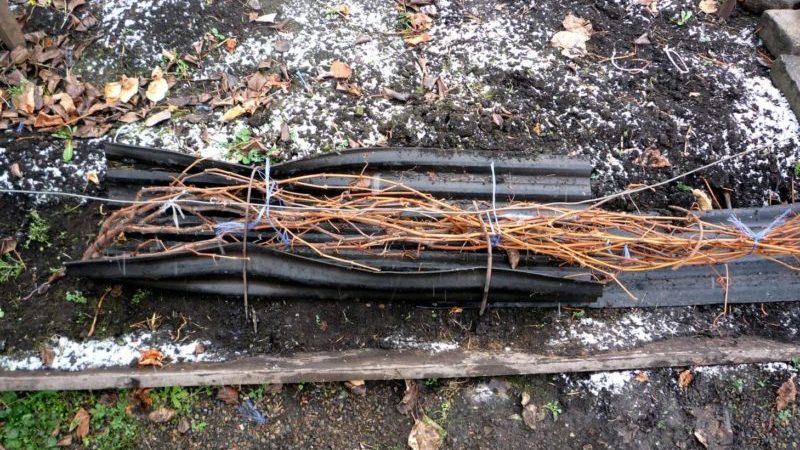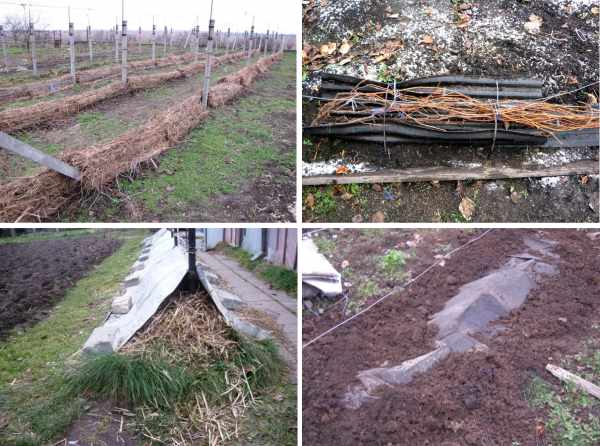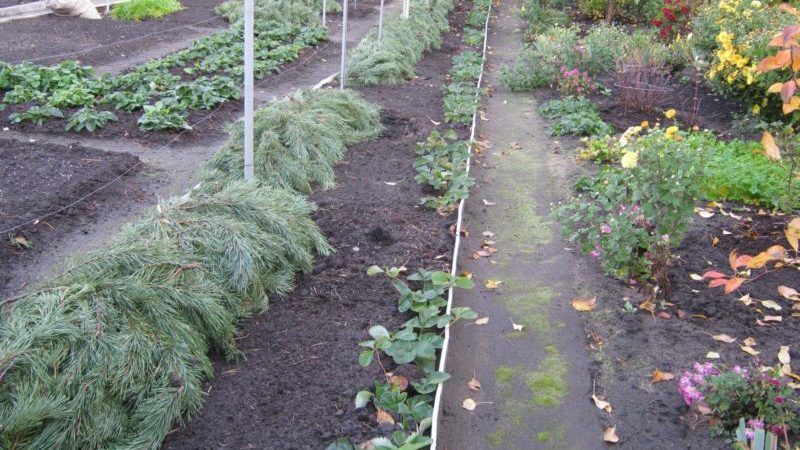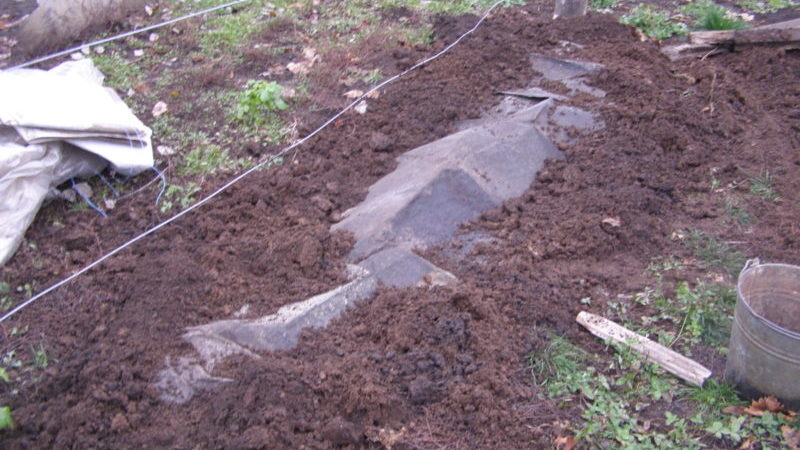Features of warming grapes in the Moscow region: how and when it is better to cover for the winter
Heat-loving grapes has long been successfully grown in regions with not the most comfortable climates, including the Moscow region. The varieties that are resistant to the vagaries of the weather are not inferior in taste and quality to the southern ones. However, the owners of vineyards near Moscow should take care of preserving the bushes from winter frosts.
The content of the article
Features of the climate of the Moscow region
The climate near Moscow belongs to the temperate continental type. Differs in a limited period of positive temperatures, their sharp drops throughout the year. The warmth at the end of summer is often replaced by prolonged cold rains.
Shelter terms for bushes in the Moscow region
Shelter for the winter is carried out after the harvest of late varieties in October-November. The exact time depends on the varietal characteristics and the age of the plant.
At what temperature to cover grapes

Ripe vines must undergo hardening by the first cold snap at a temperature of + 3 ° C to 0 ° C. The first wave of frost will stimulate the plant's immunity, increase frost resistance.
When the temperature is set from -5 ° C to -8 ° C, the grapes are covered. If it is not possible to get to the site during the onset of stable frosts, then the insulation is carried out earlier, not forgetting to build two vents on the sides of the shelter. At -10 ° C, the ends are closed completely.
Which grapes do not need to be covered and why
Some varieties of frost-resistant grapes for open ground are called non-covering. But it is possible to abandon any insulation of the bush only after 3-5 years, when it gets stronger.
To check it will be enough to leave one "sleeve" of grapes in the open air for the whole winter, and in the spring to check the condition of the eyes for survival. If about 75% has survived, then the next winter the bush does not need protection.
Important! The main task of the shelter is to ensure a stable temperature: the kidneys should not freeze or, conversely, grow ahead of time.
How to prepare grapes for shelter in the suburbs
The preparation of grapes for wintering in the Moscow region begins after the harvest and leaf fall. Autumn agrotechnics is aimed at the rapid restoration of plant strength, pest and disease control.
Pruning
Autumn pruning grapes - a sanitary and anti-aging procedure at the same time. After leaf fall, dry, diseased and damaged shoots are removed. To form the crown, cut off the excess branches, unripe vines.
Important. Embossing grape vines will contribute to its lignification, increase winter hardiness. To do this, at the end of summer and autumn, the tops of the shoots are removed, which have outgrown the trellis.
Watering
Moderate watering will be beneficial for grapes, especially in dry autumn. Sandy soil is watered more often, but in small portions of water. Clayey ones are irrigated 1-2 times, depending on the groundwater level. Well-moistened soil around the bush freezes less.
Top dressing
Before wintering, grapes are fed with a mixture of mineral fertilizers. For 10 liters of water, you will need potassium salt and superphosphate, 25 g each.Wells 15-20 cm deep are made around the bush and spilled with a solution (10 liters per plant).
Foliar dressing is useful in a period when the foliage has not yet fallen. Boric acid, mixtures based on potassium, phosphorus are suitable for them.
Fertilizers should not contain nitrogen, otherwise it will provoke plant growth.
Treatment against diseases and pests
After pruning, the grapes are sprayed for medicinal and prophylactic purposes. A solution of 10 tbsp helps from pathogens. l. salt and 5 tbsp. l. baking soda in 10 liters of warm water. Liquid process bushes completely, at least three times in mid-September.
Spraying with copper sulfate will destroy both infections and hibernating pests. The substance is dissolved in warm water in a ratio of 1:50 and the grapes are treated on both sides. One bush takes about 2 liters of liquid. After 15-20 days, the procedure is repeated.
Vegetable or any other last year's material with which the grapes will be insulated can be a carrier of pathogens. To eliminate the risk of infection, they are sprayed with an antifungal drug. For this purpose, Bordeaux liquid is well suited, which has a wide spectrum of action.
For self-preparation of the solution, take 500 g of slaked lime, 250 g of copper sulfate and dissolve in 8 liters of warm water. After processing, the raw material is dried.
By autumn, bundles of herbs with phytosanitary properties are harvested: calendula, tansy, wormwood, marigolds. They are laid out in straw, fallen leaves.
Shelter methods

The degree of protection of grapes from frost depends on the region, variety, general condition of the plant. With any method, the main rule is the insulation of the root zone.
The influence of climate on the way of sheltering grapes
In the climatic conditions of the Moscow region, where frosts are below -20 ° C, grapes are required harbor... During winter, it is recommended to adjust the degree of protection, periodically ventilate in warm weather.
Stamp dripping
The method is suitable for protecting young winter-hardy grape varieties. In the fall, the shoots are not cut off, but tied into a bunch. Vines are laid on a sheet of plywood or wire, the lower part of the trunk and the head of the bush are sprinkled with earth.
The size of the earthen mound should be proportional to the root system and the age of the bush. The approximate parameters of the shelter are 10-25 cm in height, the diameter is from 30 cm.
This method will help the plant withstand frosts down to -15 ° C. If the winter is harsher, a tighter shelter will be needed.
Semi-shelter
The method is suitable for combined varieties - their tops are more frost-resistant than the root area. As a shelter, plant materials are suitable, which mulch the ground around the base. Additionally, they throw in agrofiber and fix the edges so that the wind does not blow away.
Full cover
The method involves removing branches from the support, bending to the ground and completely covering them with a structure of 2-3 materials. In the conditions of the Moscow region, the method provides 100% security.
Snow
Mature bushes of frost-resistant grapes will perfectly endure the winter near Moscow under the snow cover. The layer should be at least 40 cm, periodically additional snow is thrown.
The ground
The grapevine is pinned with arcs to the ground, and a layer of soil is poured on top from the row spacings, but away from the roots. In the Moscow region, it is recommended to make a triple shelter: 15 cm of ordinary land, 15 cm of compost on it, 20 cm of loose soil on top.
Straw or reed
The vines are laid on boards and covered with a layer of straw or reed 20 cm thick. As the temperature drops, the same layer is added from above, fastened with arcs, spunbond or covered with snow. To prevent rodents from settling, they lay out poisonous baits.
Foliage shelter
Dry foliage is a proven thermal insulation material. It is used as an independent shelter or as a layer of a frost protection system.
Spruce branches

Spruce branches with a "pillow" of 10-15 cm are laid out under the grapes. Place the vine on top and again cover with spruce branches.
Shelter in a trench
In cold climates, grapes are often grown in trenches 20-30 cm deep.In preparation for winter, branches are bent to the ground, insulated with improvised raw materials - straw, mulch, spunbond - and covered with boards, shields, polycarbonate.
With the usual planting bushes trenches are dug along the growth line, vines are likewise tied, laid in furrows and insulate.
Dry shelter
For the climatic conditions of the Moscow region, dry shelter technology is the best option. It simultaneously solves the problem of insulation, stabilization of the temperature regime, and prevents the accumulation of condensate inside the structure during a thaw.
For air exchange, a bundle of straw or a plastic bottle without a bottom and a lid is inserted into the ends, with the neck out. With the onset of severe frosts, the vents are closed.
Slate
Slate building material is used with additional shelter, for example, burlap:
- dug trenches about 30 cm deep along the bushes;
- the vine is wrapped in burlap and laid in the furrows;
- covered with pieces of slate, covered with earth.
Film

The plastic wrap is stretched over the pre-installed frame across the vine rows. The edges are pressed with weights. In regions with severe winters, this material will not be enough. Under the film, the bushes require additional thermal insulation material and insulation - for example, roofing material and spunbond, agrofiber are suitable.
Important! Condensation on the film must not be allowed. This can lead to damping of the vine and the development of fungus.
Roofing material
A structure is made of metal arcs to which roofing material is attached. The bushes are pre-insulated with a lighter breathable material. Such a shelter requires regular ventilation.
Boxes
Cardboard boxes keep heat well, but they must be covered with a denser waterproof material.
Other materials
Gardeners have adapted to using many other materials with useful thermal insulation properties:
- car tires without disks;
- fiberglass or special construction vapor-permeable films;
- wooden boxes;
- styrofoam, sawdust, hay.
Gardeners of the Moscow region prefer not to take risks and insulate the ground and underground parts of the bush using a dry full method. Snow will only be an additional natural protection.
Features of the shelter of young grapes
In the first two years from the moment of planting, young grapes, even of non-covering varieties, are vulnerable and need protection... Shelter period is on the eve of the first frost, even if the leaves have not yet slept.
A compact first-year bush can be covered with a plastic bottle without a top, add straw, paper, foliage and cover with soil. In subsequent years, they are insulated with full or incomplete shelter.
Opening dates after wintering
The frost protection is removed at an average temperature of 0 ° C. As a rule, this time falls in the first week to mid-April. At average + 10 ° С per day the grapes are fully openedas the buds are already starting to grow.
Common mistakes and how to avoid them

A rush to cover the grapes or warming too late can lead to the complete or partial death of the plant.
Frequent mistakes:
- no pre-winter preparation of the bushes has been carried out;
- too little or too much soil is poured, especially over the film;
- the root system is not sufficiently protected;
- soil for insulation is taken from under the bush itself.
Conclusion
For a successful wintering of grapes near Moscow, a dry and complete shelter is suitable. Annual and young seedlings require maximum frost protection. Rationally used materials should warm, not let water through, but at the same time not interfere with air exchange. In the spring, do not rush to remove the shelter so that the plant does not experience the stress of hypothermia.